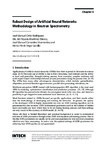
Please use this identifier to cite or link to this item:
http://ricaxcan.uaz.edu.mx/jspui/handle/20.500.11845/721Full metadata record
| DC Field | Value | Language |
|---|---|---|
| dc.contributor | 6207 | es_ES |
| dc.contributor.other | https://orcid.org/0000-0002-7081-9084 | es_ES |
| dc.coverage.spatial | Global | es_ES |
| dc.creator | Ortíz Rodríguez, José Manuel | - |
| dc.creator | Martínez Blanco, María del Rosario | - |
| dc.creator | Cervantes Miramontes, José Manuel | - |
| dc.creator | Vega Carrillo, Héctor René | - |
| dc.date.accessioned | 2019-03-13T15:37:06Z | - |
| dc.date.available | 2019-03-13T15:37:06Z | - |
| dc.date.issued | 2013-01 | - |
| dc.identifier | info:eu-repo/semantics/publishedVersion | es_ES |
| dc.identifier.isbn | 978-953-51-0935-8 | es_ES |
| dc.identifier.uri | http://localhost/xmlui/handle/20.500.11845/721 | - |
| dc.identifier.uri | https://doi.org/10.48779/dezm-yc98 | es_ES |
| dc.description.abstract | Applications of artificial neural networks (ANNs) have been reported in literature in various areas. [1–5] The wide use of ANNs is due to their robustness, fault tolerant and the ability to learn and generalize, through training process, from examples, complex nonlinear and multi input/output relationships between process parameters using the process data. [6–10] The ANNs have many other advantageous characteristics, which include: generalization, adaptation, universal function approximation, parallel data processing, robustness, etc. Multilayer perceptron (MLP) trained with backpropagation (BP) algorithm is the most used ANN in modeling, optimization classification and prediction processes. [11, 12] Although BP algorithm has proved to be efficient, its convergence tends to be very slow, and there is a possibility to get trapped in some undesired local minimum. [4, 10, 11, 13] Most literature related to ANNs focused on specific applications and their results rather than the methodology of developing and training the networks. In general, the quality of the developed ANN is highly dependable not only on ANN training algorithm and its parameters but also on many ANN architectural parameters such as the number of hidden layers and nodes per layer which have to be set during training process and these settings are very crucial to the accuracy of ANN model. [8, 14–19] | es_ES |
| dc.language.iso | eng | es_ES |
| dc.publisher | IntechOpen | es_ES |
| dc.relation | https://www.intechopen.com/books/artificial-neural-networks-architectures-and-applications/robust-design-of-artificial-neural-networks-methodology-in-neutron-spectrometry | es_ES |
| dc.relation.uri | generalPublic | es_ES |
| dc.rights | Atribución-NoComercial-CompartirIgual 3.0 Estados Unidos de América | * |
| dc.rights.uri | http://creativecommons.org/licenses/by-nc-sa/3.0/us/ | * |
| dc.source | Artificial Neural Networks - Architectures and Applications, Editado po Kenji Suzuki, Universidad de Chicago | es_ES |
| dc.subject.classification | CIENCIAS FISICO MATEMATICAS Y CIENCIAS DE LA TIERRA [1] | es_ES |
| dc.subject.other | Artificial Neural Networks | es_ES |
| dc.subject.other | Neutron Spectrometry | es_ES |
| dc.subject.other | Multilayer perceptron | es_ES |
| dc.title | Robust Design of Artificial Neural Networks Methodology in Neutron Spectrometry | es_ES |
| dc.type | info:eu-repo/semantics/article | es_ES |
| Appears in Collections: | *Documentos Académicos*-- UA Ciencias Nucleares | |
Files in This Item:
| File | Description | Size | Format | |
|---|---|---|---|---|
| Robust design.pdf | 1,88 MB | Adobe PDF |  View/Open |
This item is licensed under a Creative Commons License
